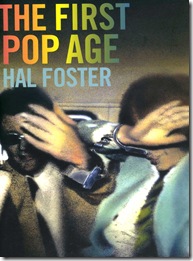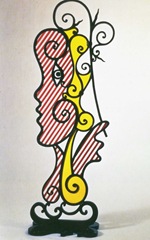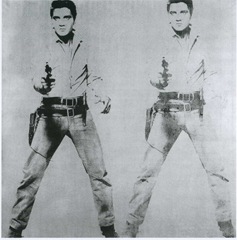Some months back THE GENERALIST reported on the death of Richard Hamilton and my investigations into the birth of Pop Art [See Previous Post]
So was excited to receive a review copy from Princeton University Press of this new book by Hal Foster, an American professor of Art & Archaeology at Princeton, which promised a fresh view of this intriguing art movement. It delivers.
In the book’s opening essay ‘Homo Imago’, Foster writes: ‘I focus my reflections on five artists – Richard Hamilton, Roy Lichtenstein, Andy Warhol, Gerhard Richter and Ed Ruscha – because they evoke, more graphically than any others, the changed conditions of painting and viewer in the first age of Pop, which here I take to have begun in the mid to late 1950s. Stripped to its essentials, my thesis is this: a shift occurred during this time in the status of image and subjectivity alike, and the signal work of these five artists registers it most suggestively’
So the form of the book is five substantial critical investigations, all illustrated with a generous helping of artworks by each – some well-known, most fresh and interesting. Most striking in this regard are Lichtenstein’s sculptures, like ‘Surrealist Head’ (1986), none of which I had ever seen before. Quite a revelation.
Foster views the works of these artists as ‘a paradigm in picture making.’ He describes this work as ‘an attempt to give these artists more formal due, and more theoretical aspect, than they are usually afforded, to demonstrate the nuances of the imaging and their understanding alike’
The parallel he draws is with the work of Leo Steinberg, the art history professor, who wrote the book ‘Other Criteria’ in 1972, which profiles Pollock, Rauschenberg and de Kooning amongst others, and which introduced the idea of the ‘flatbed picture plane’
He examines the leitmotifs of existing Pop criticism and says these are structured around binaries: high & low culture, form & content, immediacy & meditation, printing & photography, manual & machines, private & public, contemplation & distraction, critique & complicity.’
Foster expands and deepens these ideas. He says that Pop is ambiguous and non-judgemental towards popular culture being ‘neither critical nor complicit’. His binaries include ‘reverence and cynicism, delight and disdain, distance and immersion'.
Pop, he says, does not return art to representation after the abstraction of the previous generation. Rather. it combines the two: ‘It differs from them both and disturbs them’
(Left) A detail from a serial image of Elvis by Andy Warhol. The image is taken from the 1960 Don Siegel movie Flaming Star. It was first exhibited at the Ferus Gallery in Los Angeles in 1962. In the original there were 16 identical images which serially faded across a 37ft canvas. A kind of art parallel to Jack Kerouac’s scroll.
These artists were confronting the ‘inflated images of consumer society’ with its media celebrities and brand-name products. They examined and probed ‘the changes that the new image technologies wrought on human nature’. He says they took apart ‘ the cliches of celebrity and commodity to see how they work and put them back together with differences.’
In the process, says Foster, there was a shift in the function of the artist from romantic creator to trained designer and points out that Hamilton and Lichtenstein trained as draftsmen, Warhol was an illustrator and Ruscha a graphic designer. (He could have added that Rosenquist began by painting billboards).
There’s so much more insight and depth to explore in this deft, nuanced work. These essays will repay repeated reading. If I had to draw a parallel it would be with Greil Marcus’ ‘Lipstick Traces’ – both books combine new scholarship with fresh insights and stylistic innovation, to refresh our perspectives.
The book also contains more than 50pp of references and notes which contains a mine of sources of great value.
This is certainly a major contribution to our understanding of the Pop Art shift and its continuing significance and importance. It seems to have taken us more than fifty years to really appreciate how profound the changes were. We have Hal Foster to thank for opening our eyes and minds with this important and iconic volume.
ADDITIONAL NOTES:
1. Marcel Duchamp was a mentor and exemplar for many of the Pop Artists. Hamilton made his first visit to the US in 1963. He travelled with Duchamp and met Warhol, Lichtenstein and ‘other young bucks of American pop art’.
2. There is a very good overview piece on Pop Art on the wonderful site The Art Story. The essay quotes Hal Foster at length and provides a good summary of the ideas in this book: ‘The critic Hal Foster has anatomized Pop art as consisting of essentially five different image types, each of which is preoccupied with a slightly different problem, and each of which has been importantly influential on subsequent artists. ‘
3. Whilst researching for this piece, discovered this excellent profile/interview with Ed Ruscha by Rachel Cooke for The Observer in 2010.
"I like to think the California sun has burnt out all unnecessary elements in his work," says film director David Lynch. "[He is] the visual deus ex machina of what has become the most over-scrutinised city on earth," says novelist James Ellroy. "The coolest gaze in American art," said the late JG Ballard.
4. Read my Previous Post Masters of the Avant-Garde, a review of ‘Ahead of the Game’ by Calvin Tomkins, which profiles Marcel Duchamp, John Cage, Jean Tingueley and Robert Rauschenberg.



No comments:
Post a Comment